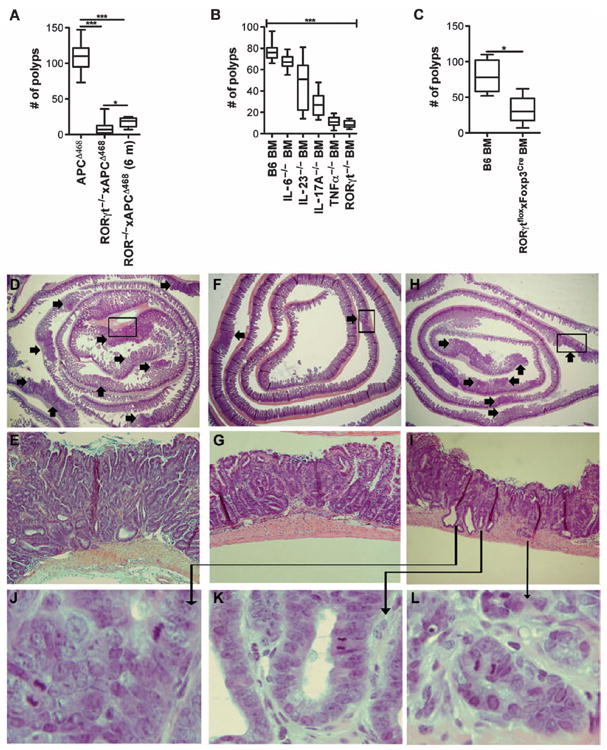Fig. 5.

Loss of TH17 cytokines reduces polyp number, but loss of IL-17 promotes invasion. (A) APCΔ468 mice were crossed to RORγt−/−, and polyp load was determined at 4 or 6 months of age: APCΔ468 = 109 ± 19, n = 25; RORγt−/−xAPCΔ468 (4 m) = 9 ± 9, P < 0.0001, n = 22; RORγt−/−xAPCΔ468 (6 m) = 18 ± 7, P < 0.001, n = 7; comparing RORγt−/−xAPCΔ468 4 m to 6 m, P = 0.0152; mean ± SD, P value determined by Wilcoxon rank sum test. (B) APCΔ468 mice were lethally irradiated at 6 weeks of age, reconstituted with BM progenitor cells from control B6 BM or BM deficient in IL-6, IL-23, IL-17A, TNFα, or RORγt, and allowed to age to 4 months of age. The number of polyps was then counted: B6 = 76 ± 3, n = 10; IL-6−/− = 67 ± 2, n = 10; IL-23−/− = 45 ± 6, n = 15; IL-17A−/− = 27 ± 4, n = 9; RORγt−/− = 8 ± 2, n = 5; P < 0.0001 using Kruskal-Wallis test comparing all. (C) APCΔ468 mice were reconstituted at 6 weeks of age with control B6 BM or BM derived from RORγtfloxxFoxp3Cre mice and allowed to age to 4 months of age. The number of polyps was then counted: B6 BM = 80 ± 24, n = 4; RORγtfloxxFoxp3Cre BM = 32 ± 20, n = 5; P = 0.032 determined by Wilcoxon rank sum test. (D to L) Representative hematoxylin and eosin of “jelly-roll” paraffin-embedded sections from 4-month-old mice: (D and E) APCΔ468, (F and G) RORγt−/−xAPCΔ468, and (H to L) IL-17−/− BM in APCΔ468. Arrows indicate polyps. (E, G, and I) ×200 Magnification of the boxed area in the panel above. (J to L) ×400 Magnification of invasive polyps depicted in (I).
